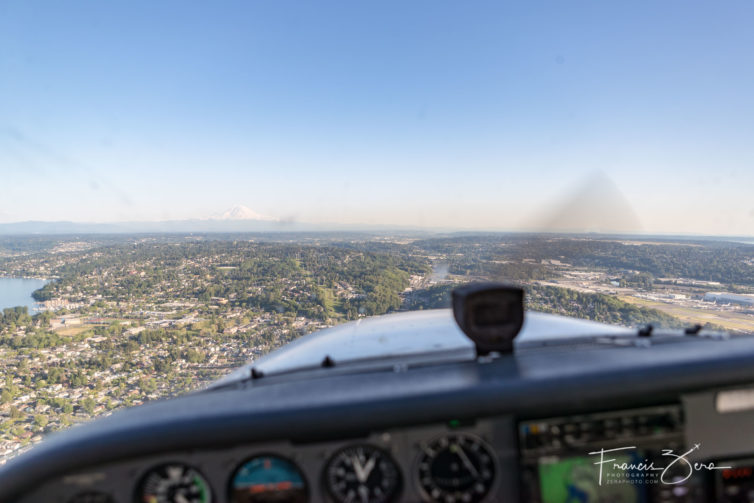
In the traffic pattern at Boeing Field. The view doesn’t suck – that’s Mount Rainier on the horizon, and the airfield is on the lower-right side of the image.
This is a continuation of my multi-part series on learning to fly. You can read the whole Fly With Francis series here.
After six weeks, which went past in a seeming eyeblink, I’ve completed ground school. Drinking from a fire hose is an appropriate analogy. Still, I passed all three written stage tests, and just passed the written comprehensive finals, which consisted of two separate tests over two class sessions. Next up will be scheduling and taking the proper FAA written exam before all this hard-earned info leaks out of my brain.
I’ve also been flying quite a lot with my CFI (aka my instructor) – two or three hours a week on average. I’m learning new skills like crazy, but am also burning through money like a Silicon Valley startup. In contrast with most of my stories, I don’t have very many photos to share for this series, not at least so far. Learning how to fly is hard, and if I’m on the controls the whole flight, there’s no time for taking photos. I’m considering finding a way to mount a GoPro either inside or outside the plane so there’s at least some video to share.
Anyway, we started doing pattern work a week or so ago; that means pretty much flying in the airport’s prescribed traffic pattern, doing a touch-and-go, then re-entering the pattern. Lather, rinse, repeat. At Boeing Field (BFI), you can get about six laps around the pattern into a one-hour lesson.
The first time we did this, it was utterly demoralizing. I’m flying a plane, which is amazing and fun, but landing is *hard*. Especially when dealing with BFI’s notoriously squirrelly crosswinds.
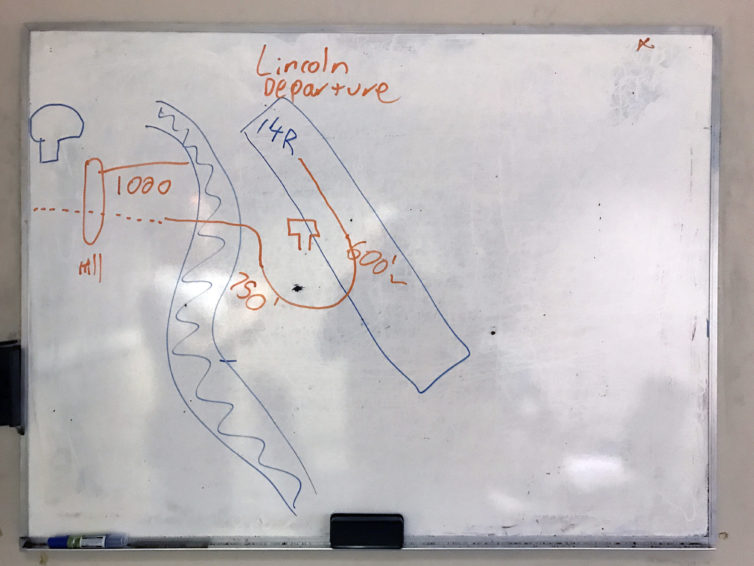
Preflight briefings include departure and approach procedures. This one is for the Lincoln departure from BFI.
Well, that, and being totally new to this thing, having to learn to think about, and control, a vehicle that moves in multiple attitudes at once, all the while developing the correspondingly new muscle-memory skills. Then combine all of that with flying in a conga line of aircraft piloted by fellow students, who are all doing similar maneuvers. Oh – and there are business jets, 737s, any number of helicopters, and a sprinkling of UPS heavy freighters tossed in for good measure. I guess I did say I wanted to learn at a busy airport; I’m definitely getting what I asked for.
I was ridiculously bad at landing the first few times (OK, all of the times). Fortunately, my attempts weren’t legendarily bad, but they were apparently bad enough to at least slightly stress out my CFI, who has to be one of the most unflappable people I’ve ever met. His normally calm, encouraging, and measured voice actually went up a couple octaves on at least one occasion when I goofed up very close to the ground, but I guess I’m holding up my end of the training bargain by providing Carl with a few challenges to repay all of that patience.
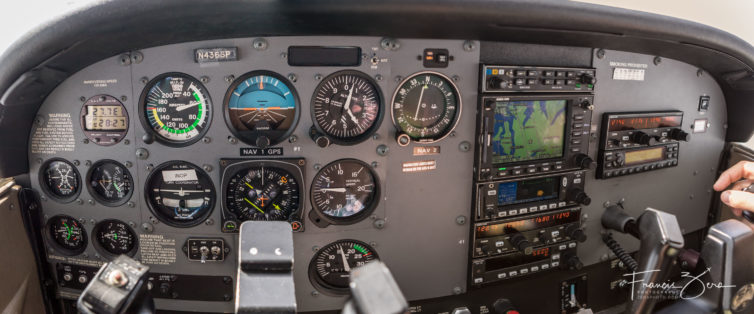
There are plenty of things to occupy your attention in the cockpit; every one of those instruments is important, some are just more important than others.
We’ve also done more ground-reference maneuvers, which consist of turns around a point (in this case, a tall water tower) and S-turns along a road, all designed to sharpen control skills. The first time we did this, the air was quite turbulent, at least by my newbie standards. The turbulence made it tricky for me to keep the nose level while in the turns, etc., but it was still fun.
The second time we did these maneuvers, there were gusty 20-knot winds to contend with, making it that much trickier to fly in a circle around the point – I kept flying ovals instead of circles, and kept gaining altitude in the turns instead of maintaining level flight. The S-turns were every bit as tricky. It was so gusty that, once back at BFI, Carl wouldn’t let me do the landing, and even he wound up doing a go-around on our first landing attempt.
This is a process best practiced by those with a lot of patience, persistence, and no small amount of humility; overconfidence and machismo are rewarded with prompt smackdowns from some combination of the four forces of flight.
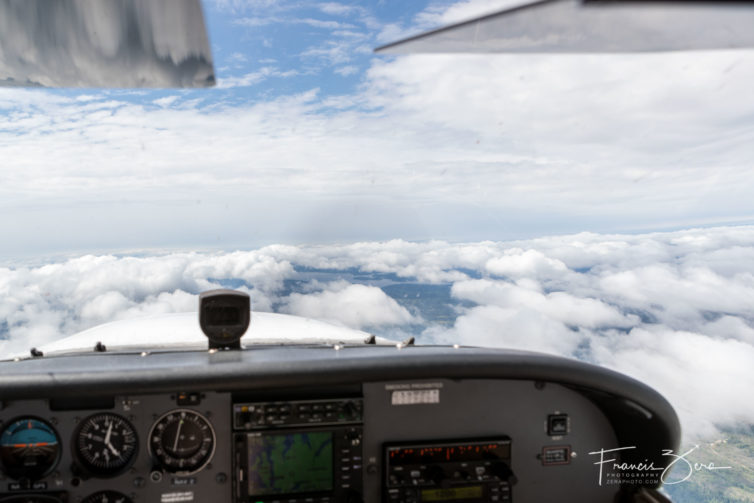
4,000 feet above the Olympic Peninsula is apparently a good spot to practice stalls
Did I mention stall training? We did that on a calm day (well, the first time, anyway), flying the plane in slow flight then pitching up until we lost lift. It was actually quite difficult to do that – the Cessna wants to fly straight and level; guess that’s why it’s such a successful training aircraft.
We also did power-on stalls; those are to simulate a stall during takeoff, which is something to be avoided (all stalls are to be avoided; practicing them in safe conditions is essential for knowing how to handle one if things go a bit wrong). Knowing how stalls feel, and the resulting knowledge of how to avoid and recover from them are great for confidence.
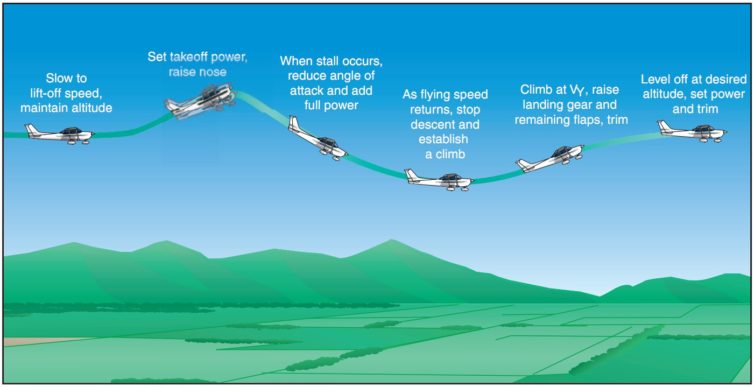
Illustration of a power-on stall, from the FAA Airplane Flying Handbook
We’ve also gone through simulated engine failures, beginning in the simulator, then practicing them in the aircraft. In the sim, Carl said he’d discovered a new failure mode in the software and was eager to try it on me. He actually giggled while I was doing the takeoff and climbing to the assigned altitude.
Once I was established in level flight, he asked if I was ready. A couple seconds later, the sim went silent and the nose pitched up, quite dramatically. He asked how the plane felt; I was guessing, but asked if he’d programmed parachuters who’d just jumped out. He laughed. “Your engine just fell out of the bottom of the plane.”
That explained the nose-up pitching moment I was dealing with. I did manage to run through the memory items and set the plane down on a runway at an adjacent airport, albeit very hard, but I was generally pleased with how it went, at least this time.
Flight training, Boeing Field, Seattle (BFI) from Francis Zera on Vimeo.
Really enjoying this blog, your writing style is quite engaging. Looking forward to more!
Great series Francis. You’re really making me miss pattern work at BFI.
As to your failure mode, I think if the engine fell out in real life, a hard landing that you walked away from would definitely count as a win!